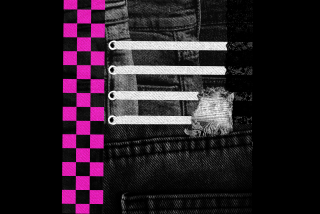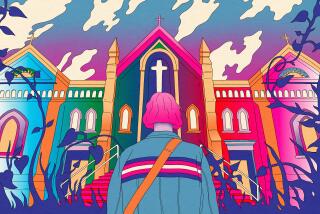Identity Crisis : Skinheads Aren’t All Alike, O.C. Teen-Agers Say in Defense of Their Subculture That Believes in Racial Harmony
Paul says he gets annoyed when he hears about crimes like the gay-bashing spree in Laguna Beach last year and the recent fatal shooting of a black man in Huntington Beach. He not only gets angry over the suffering of the victims, but also when the suspects are called skinheads.
Those who commit crimes based on race prejudice, says the Fullerton High senior, are not true skinheads--unlike Paul, 18, who is.
“Racist, Nazi, bonehead” are just a few of the terms he calls the people who seem to dress and wear their hair like him, but whose ideology and moral philosophy differ.
Fellow Fullerton resident Bobby Aragon agrees.
Being a skinhead, a true skinhead in the traditional sense, is not about being racist and it’s especially not about swastikas, says Bobby, a La Vista High senior. A patch on his black flight jacket features a swastika in a red circle with a red slash through it.
To Bobby, Paul, their network of friends in Orange County and the thousands worldwide they consider part of their scene, skinhead culture claims a rich, complex history three decades old that has been besmirched at the hands of extremist politics and misinformed perceptions.
Much attention has been focused on the packs of nearly bald teens with swastikas inked on their clothes and skin who align themselves with the white-power Nazi revivalists. You’ve seen them on Geraldo a zillion times.
As threatening and dangerous as they may be, these people are not true skinheads living the skinhead culture, insist Paul--who requested anonymity--and Bobby.
Skinheads, the teens note, take pride in dressing smart, listening to the Jamaican-born sounds of ska and reggae, and living a way of life that cherishes the blue-collar work ethic and doesn’t compromise their ideals--including interacting with fellow skinheads no matter the color of their skin.
In contrast to what most might think about skinheads, Bobby, a Native American who claims Pima, Yaqui and Mayan blood lines, says “there are no racial barriers” among them.
He learned about skinheads four years ago after two years spent as a misguided punk rocker, he quips. Bobby, 19, hung around skin friends and studied the culture, but it wasn’t until this past March that he shaved off his thick locks to a fuzz and fully adopted the look.
Most people at school know Bobby’s a traditional skin--even though he’s shared the campus with two “boneheads.”
“If they don’t want to believe I’m not racist, fine. I know I’m not,” he says.
“We have a problem equally with anyone who’s not a skin,” he continues. “We have a problem with anyone who’s for black power, brown power, white power. They’re all racists.”
Law enforcement is aware of this sub-group, says Gary S. Paer, a deputy district attorney in the county gang unit. “There’s definitely a skinhead faction that we know about that preaches against racism and that dresses like racist skinheads,” he says.
“Regular skinheads,” he adds, “don’t like them because they go against their main philosophy of white purity.”
But Paer notes that these anti-racist skins are in the minority--even when it comes to labels. “When you say skinhead, most people associate the term with those skinheads whose philosophy is racist.”
*
Skinheads trace their origins to around 1964, to the working-class neighborhoods of England, as another youth culture, the Mods, was beginning to wane. Mods, like most youth cultures before and after them, defended their music, look, territory and very existence through street fighting. (Rent the Who’s “Quadrophenia” film.)
A branch of hard mods around this time began to favor a harsher, more aggressive image. They sported short polished boots and even shorter haircuts; a neat look some parents actually approved of.
Fans of Jamaican ska and American soul, these skinhead predecessors began frequenting parties with their West Indian neighbors. Many of these younger black immigrants adopted the “rude” taste for snappy suits, wrap-around shades and violence so in vogue back home in Kingston. Jamaican rude boys and rude girls rallied around ska and its newer, slower form, rock steady. And when reggae emerged from rock steady in Jamaica around 1968, it did also in England. Skins were to draw from this influence both in fashion--wearing trousers ankle-length to expose boots--and in attitude--always ready for “aggro,” or fighting.
Another oft-overlooked influence in early skinhead cultural development was England’s World Cup victory in 1966, according to author George Marshall in “Spirit of ‘69: A Skinhead Bible” (1991, ST Publishing, Scotland), the most authoritative and objective documented history of skinheads. Young fans began attending with friends instead of family and showing their team pride through catchy chants and violence directed at the opposing team’s supporters.
By 1968, skinheads had a name and a uniform. It had nothing to do with psychedelic hippy gear of the time, instead taking its cue from the good old blue-collar ranks. In between the cropped hair and boots, skins wore corduroys or jeans, shortened or cuffed 1 1/2 inches. The ideal shirts were button-down Ben Shermans and the tennis style Fred Perry, with skinny braces (suspenders). When the occasion was--and still is--special, the wardrobe consisted of brogues, mohair suits and, for the “birds” (girls), minis instead of trousers.
Hair was cropped short, never worn bald. Young women wore theirs in a feather cut, usually cropped on top, with short bangs and longer, wispy strands at the sides and back. The crop tops were not, as has been hastily assumed, a reaction to long, dirty hippy hair.
In all, the look demands great attention to detail, down to polished shoes or a properly folded handkerchief (as detailed in Marshall’s book).
*
The mid-’70s marked another era for skinheads, including factors that would mar an already less-than-angelic reputation. Skinhead culture had already been experiencing a deluge of newer members who had little interest in anything other than expressing the full power of their boot at football games, clubs or the local street corner.
A troubled economy got worse and young people increasingly believed there was no future. The influx of poor immigrants from Pakistan and India only worsened the situation in the minds of many English, young and old.
Paki-bashing, as it was all called, became a form of racism fueled by economics. The English, including immigrants who had arrived only a decade before, saw this new wave from one of Her Majesty’s former British colonies taking away their jobs, their housing and state services.
The inflamed aggression of the newer skinheads became a target for two extreme right-wing organizations gaining attention, the National Front and the British Movement. Their enthusiastic recruitment campaign shrouded in the flag appealed to many youngsters seeking validity. The National Front and British Movement not only approved of their hate rampages, they encouraged them in the name of patriotism. The media began to brand all skinhead fans as fascist youth.
In “Spirit of ‘69,” Marshall notes the ironies. On one hand, newspapers would print photographs of so-called racist skinhead bands but would ignore that those groups included black members. On the other hand, the new fascist faction considered bands who sang against racism as communists--even though they were singing about Poland’s Solidarity movement.
By the ‘80s, the Ku Klux Klan in the United States was following the National Front’s cue, as did other racist and fascist groups internationally.
The second and third coming of ska, in 1978 and 1988, however, breathed new life into the traditional skinhead culture. There was also the convergence of ska and punk into what became known as Oi!
Indeed, after the late ‘70s, both camps claimed their own bands, record labels, fanzines and following worldwide.
Among the more respected sources still in active circulation is the Skinhead Times out of Scotland, which reports on everything from skewed news on skinheads by the media and the negative activities of Nazi supporters, to the birth of children from skinhead parents (cute baby pictures included).
But to the dismay of true skins, their culture would always be marked by perceptions of racism.
*
Youth cultures thrive on their inherent sense of being outsiders and few have experienced greater alienation than skinhead culture. The added drama of being branded fascist or racist only seems to reinforce their determination to keep the original concept alive.
The United States claims two of the largest non-racist skinhead organizations, the United Front and Skinheads Against Racial Prejudice (SHARP).
Paul, the Fullerton High senior, wears a SHARP button on his red Fred Perry shirt. When he was a sophomore, he learned about the movement through an older friend. This semester he included the SHARP logo of a boot stomping a swastika in a collage for his art class.
Initially, he recalls, his art teacher only saw the swastika and disapproved of his entry. Once he asked her to look at the larger picture and he explained what SHARP and the traditional skinhead culture was all about, she “thought it was cool.”
“A lot of my teachers are cool about it once we talk,” Paul says about his image. He spends a lot of time educating others about traditional skinhead culture and its anti-racist stance--but never around the dinner table at home.
He says his views contrast sharply with his father’s, who has a fixed opinion of Jews and blacks. Paul says he and his siblings long ago gave up debating with their father.
This “education” process not always involves talk. Being anti-racist doesn’t include being anti-violent. Skinheads have always expressed themselves however they see fit. Most group in crews--gangs, really--and adopt names that identify where they’re from.
In England it’s usually the name of the football team they support. Here, it’s a county, an English term or some other abstract connection. Occasionally crews clash, but with all the external problems they face, most try to keep the peace.
They figure their energy is better spent defending their culture. There are the racists to contend with, as well as the new generation of ska fans who insist on moshing at live shows. Skins will frequently try to stop the pit either by not moving or moving those who keep slamming into them. Usually they win on their intimidating looks alone.
“I’m not Mr. Pacifist. I don’t go looking for trouble, but if it comes, it comes,” says Paul. “We know we’re not necessarily going to make change through violence. But if we’re hanging out and we see some bonehead we’ll hit em up. It might be just verbal how we confront him. But we feel if we can wake him up with a punch. . . .”
*
Of course, much of this talk, some skins admit, is school-ground bravado. At the apartment of Paul and Bobby’s friends, John Montgomery, 19, and Amy Rados, 20, in Placentia, a couple of punks hang peacefully with them even though they visibly adhere to another way of life and dress. All of them admit to having good friends not in their scene.
Bobby’s parents have accepted his interests--with some trepidation.
“My mom’s just worried about all of us getting confused for Nazis. She’s just worried about people not knowing the difference,” Bobby says. “We tell her we explain things to people thoroughly.”
His father has also taken it in stride, except for recent concerns over the Huntington Beach slaying. So, as with other times when skinheads make the headlines, the two rehashed discussions about the differences between the two camps and reached an understanding.
“I go over things a lot of times,” Bobby says.
Amy notes that racist skinheads feel competitive with traditional skins.
“Nazis think they’re better and tougher than us,” she says. “But they have a problem with us because we’re an obstacle to them. We promote integration and are against a white America.”
Adds Paul: “We don’t believe in anarchy. We don’t like women-beaters. We’re not thugs full of disrespect for everything. We work for a living, and we don’t need people telling us what to do.”
And despite what his older brother says, Paul insists he’s not going through a phase.
“Being a skinhead is a way of life,” he continues. “It’s about pride in our work ethic, pride in being a skin. There are a lot of misconceptions about what skinheads are about. Hopefully people can learn that their definition of skinheads is not Nazis.”
More to Read
Sign up for Essential California
The most important California stories and recommendations in your inbox every morning.
You may occasionally receive promotional content from the Los Angeles Times.










